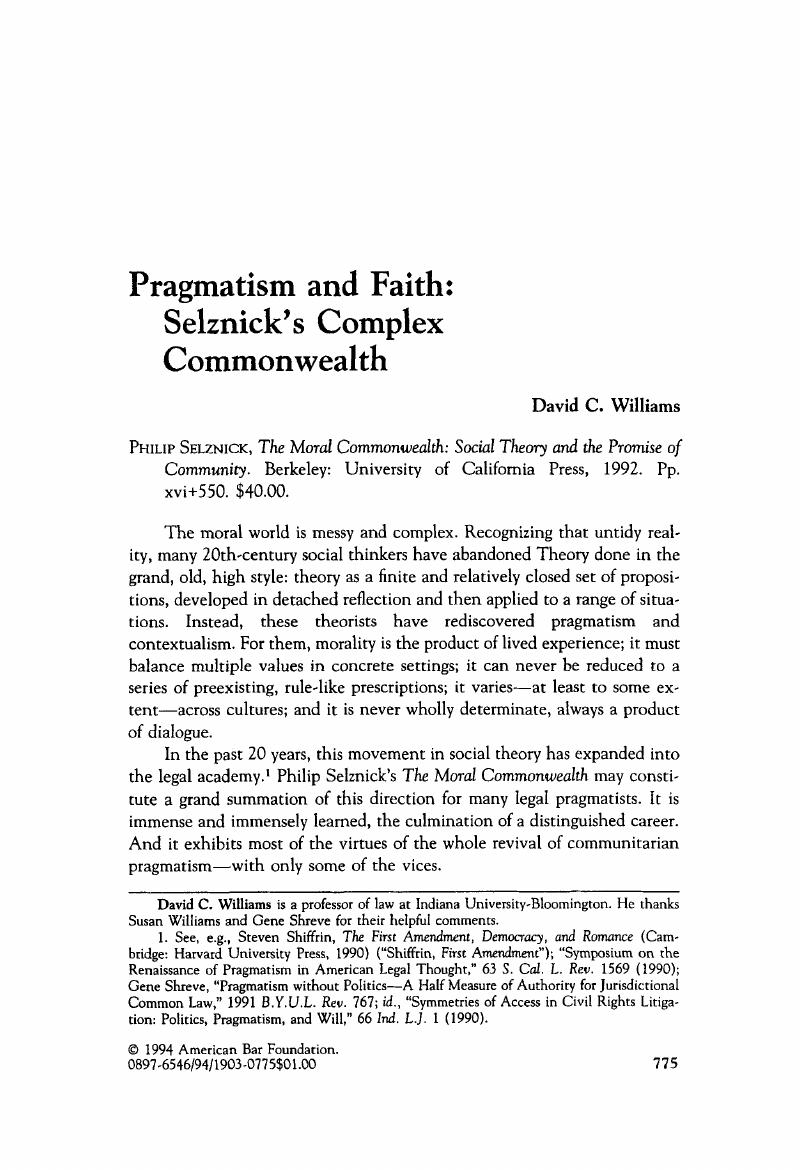No CrossRef data available.
Published online by Cambridge University Press: 27 December 2018

1 See, e.g., Steven Shiffrin, The First Amendment, Democracy, and Romance (Cambridge: Harvard University Press, 1990) (“Shiffrin, First Amendment”); “Symposium on the Renaissance of Pragmatism in American Legal Thought,” 63 S. Cal. L. Rev. 1569 (1990); Gene Shreve, “Pragmatism without Politics A Half Measure of Authority for Jurisdictional Common Law,” 1991 B.Y.U.L. Rev. 767; id., “Symmetries of Access in Civil Rights Litigation: Politics, Pragmatism, and Will,” 66 Ind. L.J. 1 (1990).Google Scholar
2 The dichotomy between baseline and higher morality apparently cuts across the distinction between universal and particularist morality. Particularist morality inspires real care, beyond minimal baseline obligations, but only to select persons. Universalist morality inspires an aspirational duty to the whole world, beyond just the baseline community, but that duty is limited in content.Google Scholar
3 This view of the English Reformation is only one among many. I offer it only as a useful heuristic to Selznick's posture in The Moral Commonwealth. Google Scholar
4 See, e.g., Alexander, Gregory, “Time and Property in the American Republican Legal Culture,” 66 N.Y.U.L. Rev. 273, 290–302 (1991); Michelman, Frank, “Law's Republic,” 97 Yale L.J. 1493, 1532–37 (1988)id., “The Supreme Court, 1985 Term Foreword: Traces of Self-Government,” 100 Harv. L. Rev. 4, 41-43 (1986); Jennifer Nedelsky, “Reconceiving Autonomy: Sources, Thoughts, and Possibilities,” 1 Yale J.L. & Feminism 7, 20-36 (1989).Google Scholar
5 See, e.g., Abrams, Kathryn, “Law's Republicanism,” 97 Yale L.J. 1591, 1604–8 (1988) Michelman, 97 Yale L.J. at 1528-33, and 100 Harv. L. Rev. at 74; Sunstein, Cass, “Beyond the Republican Revival,” 97 Yale L.J. 1539, 1576–89 (1988).CrossRefGoogle Scholar
6 Selznick might respond that he has in mind a synthetic approach: We formulate principles based on experience and then apply those principles to other situations. Unfortunately, in The Moral Commonwealth we see only the second half of that synthesis: the application of principles to examples. The derivation of principles from concrete and contextual attention to human experience occurs offstage; we have here only the summary version.Google Scholar
7 Berkeley: University of California Press, 1949.Google Scholar
8 See, e.g., Shiffrin, The First Amendment (cited in note 1); Martha C. Nussbaum, Love's Knowledge (New York: Oxford University Press, 1990).Google Scholar
9 See, e.g., Elizabeth Spelman, Inessential Woman (Boston: Beacon Press, 1988); Harris, Angela, “Race and Essentialism in Feminist Legal Theory,” 42 Stan. L. Rev. 581 (1990).CrossRefGoogle Scholar
10 See supra at.Google Scholar
11 See, e.g., Alasdair MacIntyre, After Virtue 270 (Notre Dame, Ind.: University of Notre Dame Press, 1984) (“MacIntyre, After Virtue”); Michelman, 100 Harv. L. Rev. at 22 (cited in note 4); Cornell, Drucilla, “Toward a Modem/Postmodern Reconstruction of Ethics,” 133 U. Pa. L. Rev. 291, 360–68 (1985).CrossRefGoogle Scholar
12 See, e.g., Michelman, 97 Yale L.J. at 1505 (cited in note 4); Sunstein, 97 Yale L.J. at 1548-49 (cited in note 5).Google Scholar
13 See, e.g., Michelman, 97 Yale L.J. at 1506-7; Sunstein, 97 Yale L.J. at 1554-55; Williams, David, “Civic Republicanism and the Citizen Militia: The Terrifying Second Amendment,” 101 Yale L.J. 551, 602–4 (1991).CrossRefGoogle Scholar
14 See, e.g., Hannah Arendt, On Revolution 115 (New York: Viking Press, 1963); Suzanna Sherry, “Civic Virtue and the Feminine Voice in Constitutional Adjudication,” 72 Va. L. Rev. 543, 548 (1986).Google Scholar
15 See, e.g., Ronald Dworkin, law's Empire 93-96, 164-75, 189-90, 211-15, 219-28 (Cambridge: Harvard University Press, 1986); MacIntyre, After Virtue 204-25; Cornell, 133 U. Pa. L. Rev. at 360-68; Michelman, 100 Harv. L. Rev. at 31-33, and 97 Yale L.J. at 1526-28 (cited in note 4).Google Scholar
16 Indeed, Selznick admits that conventional and critical morality really represent a continuum since both must work with available social materials and both engage in critique (at 394). The difference apparently is that critical morality reaches for acultural, universal truths about human nature, however dimly perceived.Google Scholar
17 Note that I do not mean to claim that there are no universal truths. Rather, I simply suspect that except in unusual circumstances it is neither necessary nor useful to formulate the inquiry that way: culture-bound knowledge may produce most of the benefits and fewer of the problems of universal truth claims. As I argue in the text, however, that claim like Selznick's would have to be tested by experience and in context.Google Scholar
18 For a sketch of such an argument, see Fernando Teson, “Book Review: The Ennobling of Democracy: The Challenge of the Postmodem Age by Thomas L. Pangle,” 14 Mich. J. Int'l. L. 428, 432-33 (1993).Google Scholar